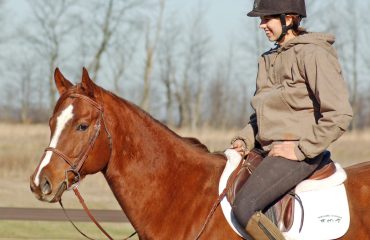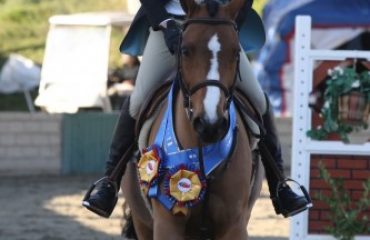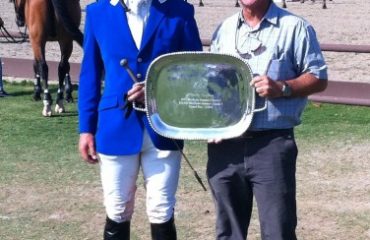By Summer Grace
On the opening day of the FEI Children’s Nations Cup at the Palm Beach Masters, 12-year-old Brooks Hull mounted a borrowed horse he had only ridden three times. Despite an obvious shiner on his left eye along with the challenge of competing on an unfamiliar horse, the young rider and his new mount headed into the ring for his very first class at the international level.
Trainer and mentor Dustin Durham was a spectacle for the media crew surrounding the event as he kicked and grabbed at the fence-line, riding the course with his young student the entire way.
A Bump in the Road
When the invite to be a part of the Children’s team had come two weeks prior, it seemed four years of intense daily training had finally paid off and Brooks would get the opportunity to represent his country in his first internationally-recognized equestrian competition. However, what should have been a celebratory moment was one of frustration and disappointment as his only horse was put on 30 days of stall rest that very same week.
As this was an opportunity of a lifetime, and a goal they had been working toward for a year, Dustin immediately began making phone calls to find a possible short-term lease for the following week. Two days later, they were on the road to Wellington, Florida, with the goal of securing a ride.
But shortly after mounting what everyone was sure would be their comeback horse, a disagreement at an oxer resulted in a nasty fall and an immediate black eye after one of the rails landed on his face.
Knowing how much this competition meant to Brooks, as well as to himself, Dustin picked Brooks up off the ground and, once cleared medically, put him right back into the saddle.
“After the fall, I was convinced I couldn’t handle getting back on or riding any more horses that day,” Brooks said. “My eye was swollen almost shut and I was banged-up, bruised and feeling like garbage. But my mom and Dustin helped me to realize that if I was going to have any shot at the Nations Cup, I needed to keep going.” 
“I knew this was a pinnacle moment for growth in his riding career,” Dustin explained. “How we recovered from this accident would stick with him for the rest of his life, so there was no way we were giving up.”
Despite his apprehension, Brooks put his trust in Dustin and they worked through his fear to successfully navigate the same horse over a full course of big fences 30 minutes later.
Finding The One
While Brooks ultimately completed several successful rounds on this horse, Audrey Robison of Anvil Ridge Farm, mentioned one other horse she thought might be a better all-in match for the tenacious young rider.
The group made a trip back to Audrey’s Loxahatchee-based farm and out came Gorky, a brave but strong grand prix horse that was proven to get over each fence. A single lap around the arena and Brooks confidently announced, “This is the one!”
The team had found the horse for the job, but there were still big hurdles to be overcome.
This was one of the few times in FEI history that a horse swap would occur after names were announced for competition. USEF representatives’ main concern was the lack of results for the new pair — after all, competitors were chosen based on points and accomplishments with a specific horse in their show career over the past recognized year. Brooks had acquired a decent record as one of the younger riders in the country competing at the low junior jumper height on Cascal E. But with an entirely new mount, Brooks was a complete wild card to the team.
Walk-Trot to International Competition
Like many other successful equestrians, Brooks began riding shortly after walking. He spent his beginning years at a local farm that catered to the basics of the sport. At the age of 8, he teamed up with his first partner, a 16-year-old Welsh mix named Jeremiah Was A Bullfrog (Froggy).
The two competed in monthly schooling shows at the walk-trot and crossrail level. But within the year, Brooks’ parents began to realize that their options for quality training in a small area such as Fort Myers, Florida, were limited. That is, until an encounter of fate put them in the path of the young and passion-driven rider and trainer Dustin Durham at a local friend’s barbecue.
After watching Brooks, a complete stranger at the time, fall off while trying to jump a single crossrail in the backyard, Dustin couldn’t help but intervene. When asked what it was that made him step in, Dustin simply says he immediately saw the young boy’s potential. With proper training and time in the saddle, Dustin knew he could fast track the young rider into a successful athlete.
“He kept getting back on that horse even when he fell off,” Dustin recalled. “I just immediately saw a young me in him, in that he had the same passion and desire I’ve always had for this sport, and to be a part of that incredible journey in a young rider’s life was something I had thought about for many years.”
Brooks’ riding routine quickly escalated to many hours a day, five days a week in the saddle, sometimes riding as many as seven horses a day. His mounts included some top-notch hunters, jumpers and sale horses, as well as Dustin’s own horse, a retired grand prix jumper.
“I put him on everything in the barn I could find,” Dustin said. “He rode most, if not all, of my own horses each day and then I would call my clients to see if I could put him on their horses too. There were many days that he had to be pushed way out of his comfort zone to do something that he felt was impossible but I’m always aiming high.”
In his first several years with Dustin, Brooks credits his most intense learning to an off-the-track Thoroughbred named Leroy Brown. The now-14-year-old gelding sat in a field for quite a few years after a short racing career and was green to the sport of jumping when Brooks, at the age of 9, took him over.
“Leroy and I basically grew up together,” he said. “Whenever we moved up a division or tackled something new, we were both doing it for the first time, so it was a unique experience because we helped train each other.”
At the age of 11, Brooks competed in the jumper ring with Leroy, and the same year qualified his 18-year-old pony, Froggy, for the USEF/Collecting Gaits Farm Pony Finals in the large pony hunter division. It was an idea that Brooks and Dustin had discussed but one that had seemed out of reach considering Froggy’s conformation and movement — he was not your classic hunter type. Still, a single successful weekend at Fox Lea Farm in the large pony division gave the pair the points they needed to head to Kentucky a few months later.
Brooks and his original walk-trot mount ticked off another goal and made their debut in the prestigious Walnut ring against almost 200 other horse-and-rider combinations. However, his real experience and development came with the investment in Cascal E in 2019.
Brooks and Cascal got to know each other for a few months while competing in the high children’s jumpers before moving on to the low junior jumper division. The transition from competing ponies and small jumper classes to larger and more technical courses was a turning point for Brooks as he came to realize the necessity of all of the hard work put in.
“I hit the dead end of talent when I began showing Cascal in the 1.10m to 1.20m divisions,” he said. “I had to figure out how to really, truly work and put in an honest effort. That’s when I started to have better overall results and become more consistent.”
Just Getting Started
 After intense competition in the team Nations’ Cup, the U.S. Children’s team jumped to a gold medal finish, a feat that Brooks contributed to by securing the first clear round in phase 1. His biggest success came with double-clear rides and a fourth place finish in the $3,000 Bainbridge CSIOCH Grand Prix.
After intense competition in the team Nations’ Cup, the U.S. Children’s team jumped to a gold medal finish, a feat that Brooks contributed to by securing the first clear round in phase 1. His biggest success came with double-clear rides and a fourth place finish in the $3,000 Bainbridge CSIOCH Grand Prix.
Shortly after their incredible weekend, the horse show industry — and much of the world — came to a screeching halt with the invasion of COVID-19. Despite stepping away from the show ring, Brooks and Dustin have taken full advantage of their time at home and have new goals for the coming fall season.
“We’ve been working towards a new goal for Brooks to compete in the regional grand prix during the Central Florida Hunter Jumper Association show in Tampa in the fall,” Dustin said. “While disappointed to have a break in the show season, we’ve been training hard and keeping things moving at the farm. Actually, I think the quarantine has been a bit good for us all to take a step back and be able to prepare at home more without the pressure of competition. That being said, we’re definitely excited to get back into the show ring.”
Brooks’ family also purchased Colloway Farms, a 17-acre property in the heart of Fort Myers where he now lives and is part of the daily care of his horses. Meanwhile, Dustin has been able to expand his training business at Colloway and continues to develop young talent consisting of both horses and riders.
“At the end of the day, we’re all here because we love horses,” Dustin said. “There’s nothing more fun than working with them and creating an environment where young riders can accomplish their dreams.”
Photos by Roger Prehoda, unless noted otherwise













